Rank Species | Genus Arnica Higher classification Arnica | |
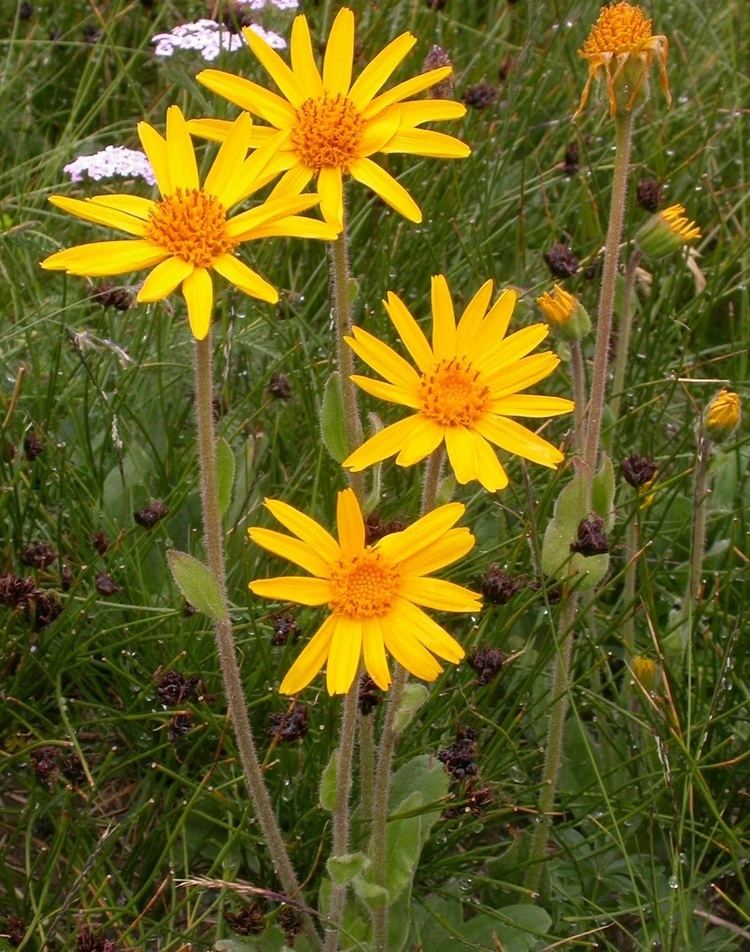 | ||
Similar Arnica, English marigold, Perforate St John's‑wort, Common comfrey, German chamomile | ||
Arnica herb arnica montana
Arnica montana, sometimes referred to as wolf's bane, has also been called leopard's bane, mountain tobacco and mountain arnica, is a European flowering plant in the sunflower family. It is noted for its large yellow flower head.
Contents
- Arnica herb arnica montana
- Arnica arnica montana
- Description
- Distribution and habitat
- Chemical constituents
- Cultivation
- Use in herbal medicine
- Toxicity
- Market
- References
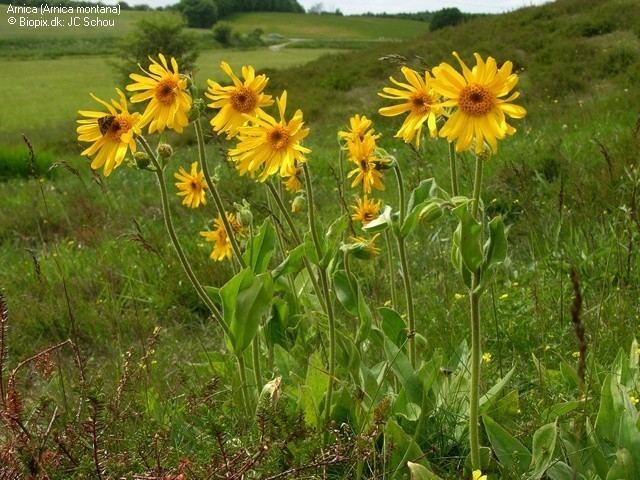
Arnica arnica montana
Description

Arnica montana is a flowering plant about 18–60 cm (7.1–23.6 in) tall aromatic fragrant, perennial herb. Its basal green ovate-cilitate leaves with rounded tips are bright coloured and level to the ground. In addition, they are somewhat downy on their upper surface, veined and aggregated in rosettes. By contrast, the upper leaves are opposed, spear-shaped and smaller which is an exception within the Asteraceae. The chromosome number is 2n=38.
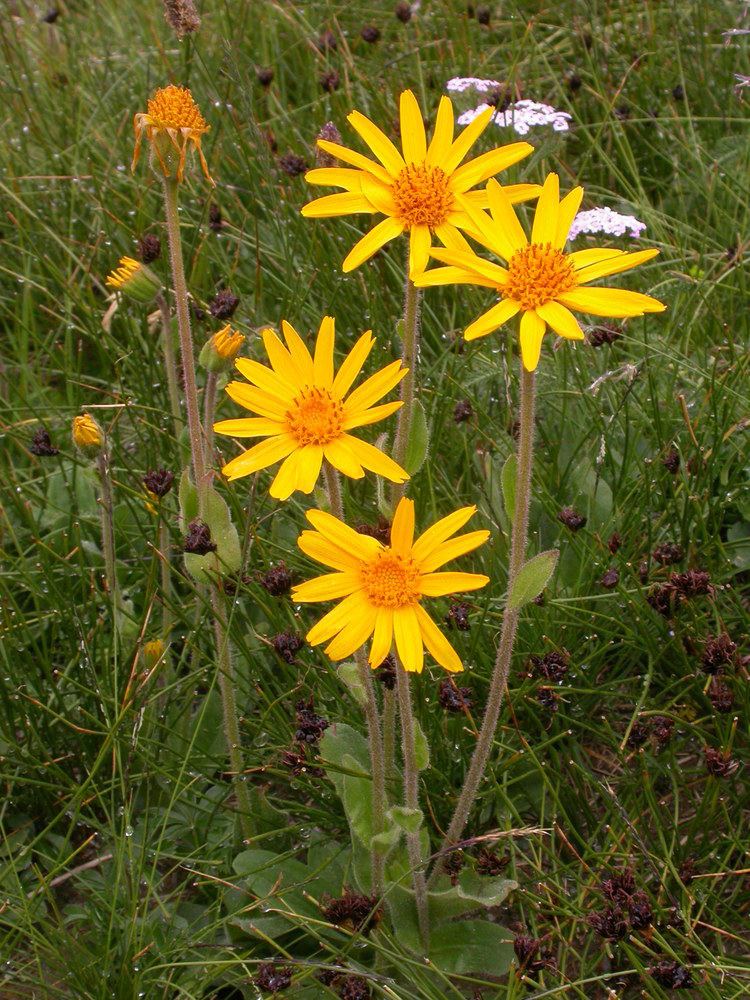
The flowering season is between May and August (Central Europe). The hairy flowers are composed of yellow disc florets in the center and orange-yellow ray florets at the external part. The achenes have a one-piece rough pappus which opens in dry conditions. Arnica montana is a hemicryptophyte, which helps the plant to survive the extreme overwintering condition of its habitat. In addition, Arnica forms rhizomes, which grow in a two-year cycle: the rosette part grows at its front while its tail is slowly dying.
Distribution and habitat
Arnica montana is widespread across most of Europe. It is absent from the British Isles and the Italian and Balkan peninsulas and Slovakia. In addition, it is considered extinct in Hungary and Lithuania. Arnica montana grows in nutrient-poor siliceous meadows or clay soils. It mostly grows on alpine meadows and up to nearly 3,000 m (9,800 ft). In more upland regions, it may also be found on nutrient-poor moors and heaths. However Arnica does not grow on lime soil, thus it is an extremely reliable bioindicator for nutrient poor and acidic soils. It is rare overall, but may be locally abundant. It is becoming rarer, particularly in the north of its distribution, largely due to increasingly intensive agriculture and commercial wild-crafting. Nevertheless, it is cultivated on a large scale in Estonia.
Chemical constituents
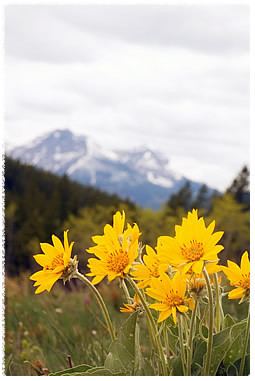
The main constituents of Arnica montana are essential oils, fatty acids, thymol, pseudoguaianolide sesquiterpene lactones and flavanone glycosides. Pseudoguaianolide sesquiterpenes constitute 0.2-0.8 % of the flower head of Arnica montana. They are the toxin helenalin and their fatty esters. 2,5-Dimethoxy-p-cymene and thymol methyl ether are the primary components of essential oils from both the plant's roots and rhizomes.
Cultivation
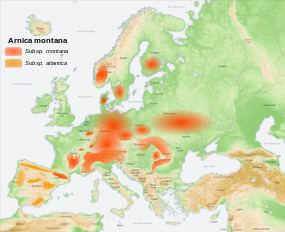
Arnica montana is propagated from seed. Generally, 20% of seeds do not germinate. For large scale planting, it is recommended to raise plants first in a nursery and then to transplant them in the field. Seeds sprout in 14–20 days but germination rate depends highly of the seed quality. Planting density for Arnica montana is of 20 plants/m2 such that the maximum yield density will be achieved in the second flowering season. While Arnica montana has high exigencies of soil quality, analyses should be done before any fertilizer input.
The flowers are harvested when fully developed and dried without their bract nor receptacles. The roots can be harvested in autumn and dried as well after being carefully washed.
Arnica montana is sometimes grown in herb gardens.
Use in herbal medicine
Historically, Arnica montana has been used as an herbal medicine for centuries.
Clinical trials of Arnica montana have yielded mixed results:
The US Food and Drug Administration has classified Arnica montana as an unsafe herb because of its toxicity. It should not be taken orally or applied to broken skin where absorption can occur.
Toxicity
A. montana contains the toxin helenalin, which can be poisonous if large amounts of the plant are eaten. Consumption of A. montana can produce severe gastroenteritis, internal bleeding of the digestive tract, nervousness, accelerated heart rate, muscular weakness, and death if enough is ingested. Contact with the plant can also cause skin irritation. In the Ames test, an extract of A. montana was found to be mutagenic.
Market
The demand for A. montana is 50 tonnes per year in Europe, but the supply does not cover the demand. The plant is rare; it is protected in Belgium, France, Germany, Italy, Poland, and in some regions of Switzerland. France and Romania produce A. montana for the international market. Changes in agriculture in Europe during the last decades have led to a decline in the occurrence of A. montana. Extensive agriculture has been replaced by intensive management.
